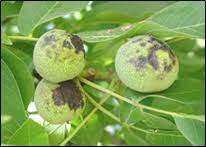
Crown Gal is caused by the bacterium Agrobacterium tumefaciens and it usually concerns young trees. The most common symptom is tumors (overgrowth) that appear in the roots, just above or below the soil line. Infected trees with many galls will gradually become unable to transfer water and nutrients to the upper parts of the tree. As a result, they slowly become weak and they finally die. The bacterium can survive for many years in the soil.
Walnut blight is a bacterial disease caused by Xanthomonas juglandis. It is the most common walnut tree disease that affects foliage and nuts. It appears most often in wet and humid spring conditions. Some of the symptoms are that the kernels shrink, wilt, mummify or discolor. Lesions may appear in the tree bark and leaves, while infected new shoots may die. Rainfall favors the rapid spread of disease, as bacteria are transferred through rainwater to new green tissues and infect them.
Armillaria root rot, Phytopthora root rot and Powdery mildew are also common walnut tree diseases.
https://wikifarmer.com/
